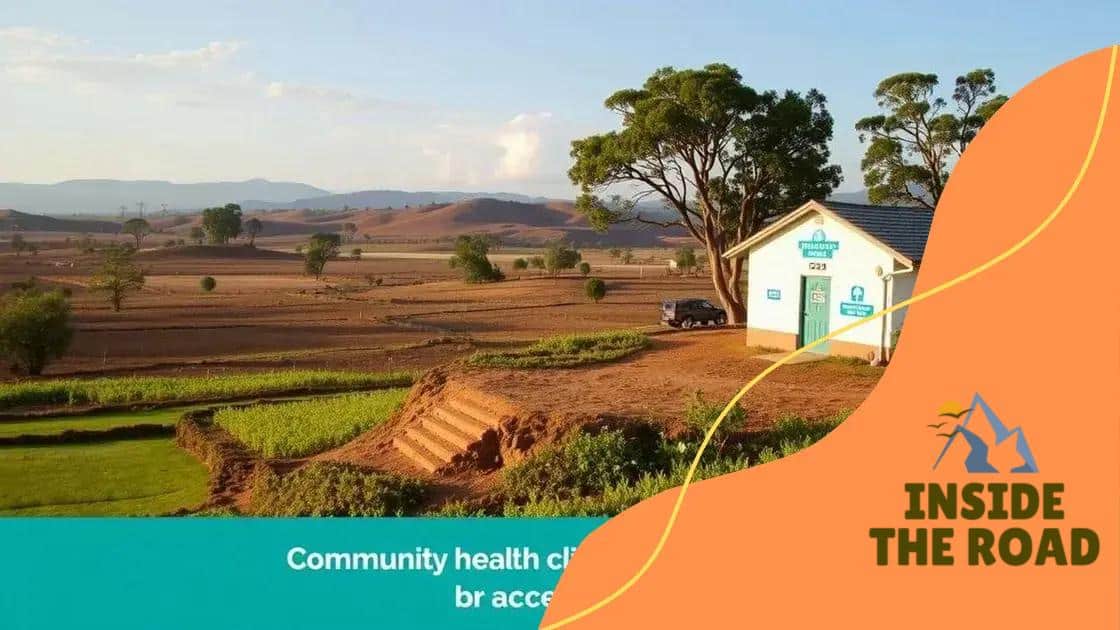Medicaid expansion in rural communities: a vital lifeline

Medicaid expansion in rural communities significantly improves health care access, boosts local economies, and addresses staffing shortages in health systems, ultimately leading to better health outcomes for residents.
Medicaid expansion in rural communities plays a critical role in enhancing health care access for many. Have you considered how these changes might affect residents? Let’s dive into the intricacies of this topic.
Understanding Medicaid expansion in rural areas
Understanding Medicaid expansion in rural areas is essential to grasp its significance for communities across the country. This program aims to improve health care access and ensure that those in need receive support.
Focus on how Medicaid expansion can change lives. Many rural residents face limited healthcare options. By expanding Medicaid, we can provide a safety net for vulnerable populations.
Key Benefits of Medicaid Expansion
There are several important advantages:
- Increased access to healthcare services
- Reduced financial burden on families
- Improved health outcomes for low-income individuals
Access to essential health services becomes a reality. Moreover, Medicaid expansion can provide significant economic benefits to rural areas. With more individuals insured, local healthcare providers can offer better services and maintain viability.
Impacts on Local Clinics
Local clinics may see an increase in patient volume. This boost helps sustain healthcare facilities, which are critical for rural populations. Additionally, clinics can enhance their services and hire more staff, benefiting the community.
In summary, understanding Medicaid expansion in rural areas reveals its importance in addressing healthcare inequalities. It serves not only as a health measure but also as an economic stimulus for rural communities.
Impact on health care access
The impact on health care access due to Medicaid expansion is profound, particularly for rural communities. Many individuals who previously went without essential services can now receive the care they need. This expansion reduces the number of uninsured individuals and increases overall healthcare utilization.
Positive Changes in Access
Medicaid expansion leads to several key improvements:
- Increased availability of regular check-ups
- Better management of chronic diseases
- Access to critical preventive services
These changes create a healthier population in rural areas. Individuals can seek treatment sooner, which often results in better outcomes and lower healthcare costs over time.
Barriers Reduced
Moreover, the barriers to accessing healthcare are significantly lowered. Transportation challenges and lack of nearby facilities are less of an issue when more people have coverage. This means more residents seek care at local clinics rather than postponing visits or relying on emergency services, which can be both costly and overwhelming.
Furthermore, Medicaid expansion helps to fill in the gaps in rural healthcare services. With more funding and support, clinics can enhance service offerings and address community-specific health needs.
Overall, the effects of Medicaid expansion create a ripple of positive change within rural health systems. When individuals gain access to healthcare services, entire communities benefit.
Economic benefits for rural communities

The economic benefits for rural communities resulting from Medicaid expansion are substantial and multi-faceted. Increased health care access can lead to greater workforce participation and productivity. When individuals have access to necessary medical services, they can return to work more quickly and maintain consistent employment.
Job Creation in Health Care Sector
Medicaid expansion also creates job opportunities in the healthcare sector. This includes:
- Hiring of more healthcare professionals
- Creation of support roles in clinics
- Investments in local health facilities
As clinics expand to meet the demand for services, they contribute to the local economy. This employment growth helps reduce unemployment and supports families in the area.
Increased Local Spending
Moreover, individuals with health insurance tend to spend more in the local economy. When more community members have coverage, they are likely to seek preventive services, regular check-ups, and treatment. This leads to:
- Higher spending at local pharmacies and medical supply stores
- Support for local businesses that provide health-related services
- Increased demand for goods and services
The infusion of cash into the community stimulates economic growth. As a result, we can see improvements not only in health outcomes but also in community vitality.
Additionally, addressing health issues through Medicaid reduces emergency room visits. This shift not only lowers costs for healthcare systems but can also decrease the burden on local economies.
Challenges faced by rural health systems
Rural health systems face numerous challenges that impact their ability to provide quality care. These challenges are often compounded by limited resources and geographical barriers. Many rural areas struggle with inadequate funding and staffing shortages, making it difficult to deliver effective health services.
Limited Access to Services
Access to healthcare can be a significant issue in rural communities. Common problems include:
- Fewer healthcare providers available
- Long travel distances to clinics or hospitals
- Infrequent public transportation options
Patients frequently must travel long distances for simple care, leading to delays in treatment and higher costs. This lack of accessibility can deter individuals from seeking necessary medical attention.
Financial Constraints
Financial issues put additional strain on rural health systems. Many small clinics and hospitals operate on tight budgets, which can limit their ability to hire staff and update equipment. Also, rural facilities often face challenges in obtaining sufficient reimbursements for services rendered. This leads to financial instability and can even result in the closure of essential health services.
In addition, rural health systems may struggle with the integration of technology, such as electronic health records, which can enhance care quality. The high costs associated with these technologies can further burden already stretched resources.
Ultimately, addressing the challenges faced by rural health systems requires collaboration among community organizations, policymakers, and healthcare providers. Together, they can work towards creating sustainable solutions that improve access and quality of care for rural populations.
Future outlook for Medicaid expansion
The future outlook for Medicaid expansion appears promising, especially as awareness of its benefits continues to grow. Many states are reconsidering their positions on expansion, recognizing the positive impact it has on rural communities.
Potential for Increased Enrollment
As more information becomes available, we can expect:
- Higher enrollment rates among eligible individuals.
- Outreach programs to educate communities about available services.
- Efforts to reduce stigma associated with using Medicaid.
These efforts can lead to an increase in the utilization of health services in rural areas, ultimately resulting in healthier populations.
State Legislation Changes
Future legislation may also play a key role in expanding Medicaid. States looking to improve their health outcomes might pursue:
- Waivers to create innovative Medicaid programs.
- Partnerships with local businesses to enhance care.
- Incentives for health facilities to increase service accessibility.
Such progressive measures will further bolster the healthcare infrastructure, making it more resilient and adaptable to community needs.
Furthermore, the ongoing discussions at the federal level about healthcare reforms will shape the landscape for Medicaid expansion. Decisions made by policymakers can result in broader eligibility guidelines and increased funding.
Given these trends, the future of Medicaid expansion holds the potential for transforming health care in rural communities, making it essential to remain engaged in advocacy and support for continued progress.
FAQ – Frequently Asked Questions about Medicaid Expansion in Rural Communities
What is Medicaid expansion and why is it important?
Medicaid expansion allows more individuals to qualify for Medicaid, increasing access to healthcare services, especially in rural areas where options are limited.
How does Medicaid expansion benefit rural economies?
It boosts local economies by creating jobs in healthcare, increasing local spending by insured individuals, and reducing reliance on emergency services.
What challenges do rural health systems face?
Rural health systems often struggle with limited resources, staffing shortages, and accessibility issues that can hinder effective care delivery.
What does the future hold for Medicaid expansion in rural areas?
The future looks promising as more states consider expansion, potentially leading to improved health outcomes and community engagement in healthcare advocacy.






